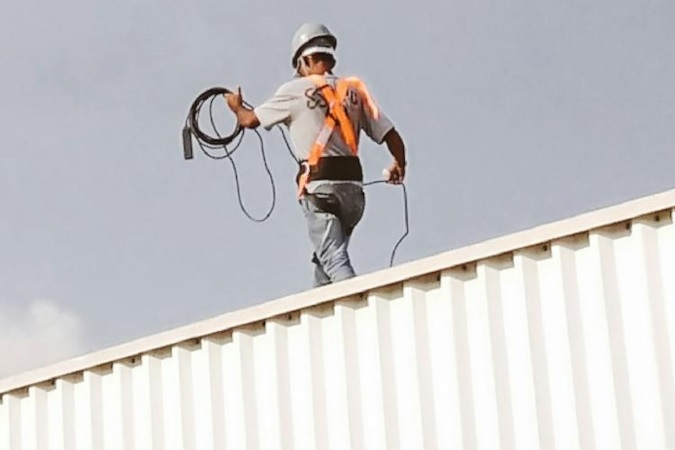
Fall protection is required when work at height is carried out and there is a realistic risk that a person could fall and suffer personal injury, and that risk cannot be removed or adequately reduced by other means.
What Counts as Work at Height?
The Work at Height Regulations 2005 define work at height as any activity where, if precautions were not taken, a person could fall a distance liable to cause personal injury.
In practice, you should treat a task as work at height if it involves things like:
- Working on a roof or near an exposed edge where someone could fall to a lower level
- Using scaffolds, platforms or mobile access equipment with a potential fall from the platform
- Working above or near fragile surfaces such as old roof sheets or skylights
- Carrying out tasks where slipping or tripping could result in a fall down stairs, into a pit or through an opening
Which Legislation Applies?
The Work at Height Regulations 2005 apply to all work at height where there is a risk of a fall liable to cause personal injury, placing duties on employers and those who control the work. According to the HSE work at height FAQs, there is no fixed minimum height; the trigger is the potential for injury, not a particular number of metres.
How to Decide If Fall Protection Is Required
The HSE’s step-by-step guide to working at height is a useful way to structure your thinking. A simple decision path looks like this:
- Can you avoid working at height altogether, for example by using extending tools to carry out the task from ground level?
- If not, identify the specific fall hazards such as edges, fragile surfaces, openings or ladder use.
- Decide whether collective protection (guard rails, scaffolds, edge protection, safety nets) can be used to prevent or arrest a fall for everyone at risk.
- If collective measures cannot fully remove or control the risk, provide suitable personal fall protection equipment for each worker.
When Should Personal Fall Protection Equipment Be Used?
Personal fall protection equipment is required when collective protection alone cannot keep people safe. Typical scenarios include:
- Short-duration work on roofs where it is not reasonably practicable to install permanent edge protection
- Tasks on ladders or stepladders that take longer, involve awkward positioning or increase the chance of overreaching
- Work near rooflights, fragile sheets or floor openings where a fall through the surface is possible
For these situations, you may need equipment such as a full body harness, lanyard and suitable anchor point. Our safety harness range includes options for general construction, maintenance, roofing and specialist tasks.
What Equipment Might I Need?
A personal fall protection system typically includes several components that must work together:
- A correctly-fitted full body harness that will keep the user upright and supported if a fall is arrested
- A secure anchor point or anchor device that can withstand the forces generated in a fall
- A lanyard or self-retracting lifeline, usually with an energy absorber or similar device to limit impact forces
- A planned rescue method, with appropriate equipment and competent people to carry it out quickly
Safety Harness Direct offers harnesses for all sorts of at-height work. For example, our 3 Point Full Body Harness by G-Force combines fall arrest and work positioning features in one comfortable design.
Employer & Worker Responsibilities
The HSE introduction to working at height safely sets out clear expectations for employers and workers. Employers must ensure that work at height is properly planned, supervised and carried out by competent people. They must provide suitable equipment, keep it inspected and maintained, and put effective emergency and rescue arrangements in place.
Workers must follow the systems of work provided, use equipment as instructed, wear their harness and associated kit correctly, and promptly report any defects or concerns so that risks can be controlled.
Common Misconceptions About Fall Protection
“It’s only a short drop, so fall protection is not required.”
The regulations focus on whether a fall could cause personal injury, not on an arbitrary height. A fall from what looks like a modest height can still lead to serious harm if you strike a hard surface or unprotected edge.
“We are only using a ladder, so the rules do not apply.”
Ladders are included in the scope of the regulations. The HSE’s work at height FAQs make clear that ladders are only suitable for low-risk, short-duration tasks. Where the risk is higher, you must use additional controls, which can include fall protection equipment.
Summary: When Is Fall Protection Required?
Fall protection is required whenever people carry out work at height where they could fall and be injured, and where that risk cannot be removed or sufficiently reduced by avoiding the height or changing the method of work. A suitable risk assessment, informed by HSE guidance, will help you decide when personal fall protection equipment is needed and which system is appropriate for the job.
Browse Fall Protection Equipment
By planning work at height carefully, following HSE guidance and selecting reliable equipment from a trusted supplier like Safety Harness Direct, you can ensure every task is carried out safely, professionally and in full compliance with the law.
Photo from Pexels

